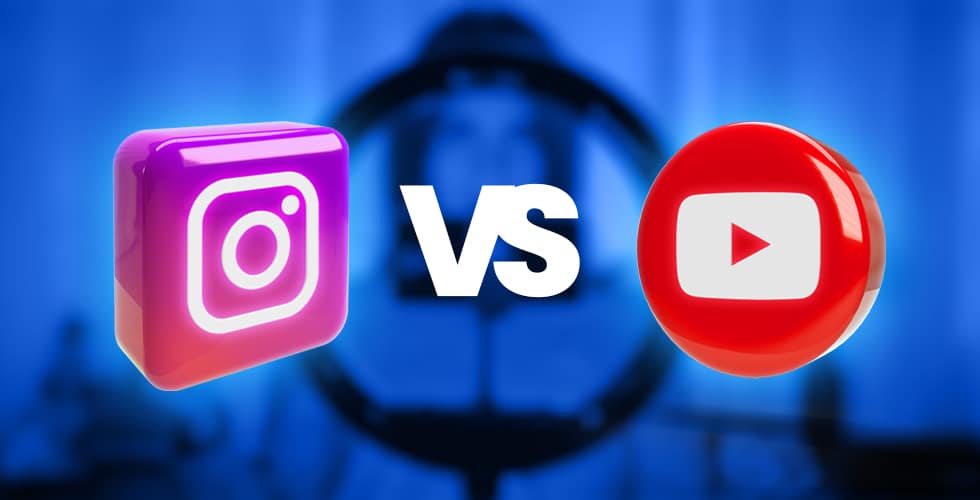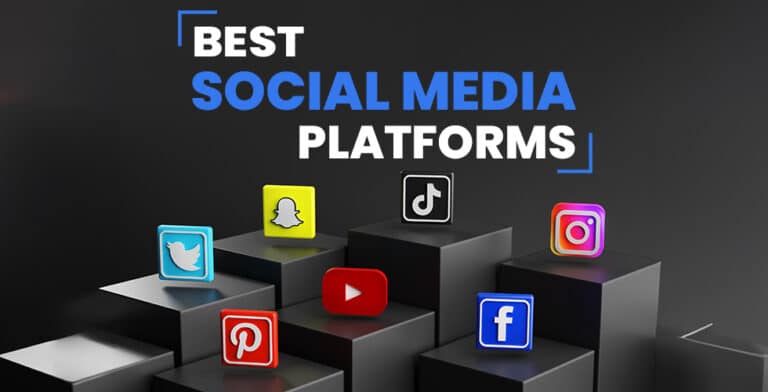Instagram has emerged as a prominent hub for influencers, known for its diverse content and quick consumption. Its format allows users to connect with influencers rapidly. In contrast, YouTube’s longer-form content may require more time for users to establish a connection.
As of 2023, Instagram stands tall with an astonishing 2.35 billion monthly active users. It ranks as the fourth most used social media platform globally, and its popularity continues to rise. This platform isn’t just about aesthetics; it’s also a financial powerhouse, generating $43.2 billion in ad revenue in 2022.
On the flip side, YouTube is a massive platform with 2.70 billion monthly users, making it the second-largest search engine worldwide. In terms of revenue, YouTube generated a staggering $7.9 billion in ad revenue in Q4 2021, reflecting its power as an advertising platform.
Whether you’re a business aiming to expand your digital presence or an influencer seeking the ideal platform, it’s essential to determine which one between Instagram and YouTube aligns better with your specific goals and influencer marketing strategy.
Instagram and YouTube: Content Creation
In the realm of content creation, Instagram and YouTube offer unique landscapes. While both platforms can accommodate a wide range of content, certain types are more prevalent on one than the other. This distinction is especially relevant when considering the format, style, and purpose of your content.
Content Style and Length
Instagram: As a platform known for its visual appeal, Instagram thrives on polished and professional-looking content. This platform caters to concise, visually striking content that often leans towards the lifestyle and fashion niches. Short videos, reels, and captivating imagery dominate Instagram’s landscape.
YouTube: YouTube, on the other hand, is a versatile platform where content can be substantially longer. It’s the go-to platform for instructional, in-depth, and educational content. How-to videos, detailed tutorials, and lengthy conversations find their home here. While YouTube also hosts professional content, it often embraces a more authentic, less polished aesthetic, particularly in vlogs.
Choosing the Right Platform
The type of content you aim to create should guide your platform selection. If your content requires depth and instructional value, YouTube’s longer format is ideal. For snappier, visually appealing content, Instagram’s concise style shines.
Instagram and YouTube: Finding Influencers
Today, YouTube and Instagram are one of the most powerful hotspots for influencer activity. Visual content’s unparalleled engagement makes these platforms indispensable for successful influencer collaborations. To maximize your results, tap into influencers on both YouTube and Instagram.

But with the rise of influencer marketing, finding the right influencers has become a complex task. So, how do you choose the perfect influencers for your business? Read on to discover key considerations. When searching for influencers, these are the factors you should take into account:
- High Quality: Nobody enjoys content with poor audio, shaky camera work, or subpar lighting. The same applies to images – low quality won’t cut it. Influencers needn’t be professional photographers or videographers, but they should consistently produce appealing, high-quality content. For Instagram influencer discovery and campaign management, tools like Combin can be invaluable. On YouTube, explore vidIQ, a versatile platform for keyword research, competitor analysis, thumbnail creation, and more.
- Engagement: When identifying influencers, prioritize the engagement rate – a crucial key performance indicator (KPI). The engagement rate represents the percentage of followers who actively engage with content out of the total followers. Simply put, a higher engagement rate leads to more effective influencer marketing.
- Strong Aesthetic Sense: Given the visual nature of Instagram and YouTube, captivating content is essential for campaign success. Seek influencers who consistently create visually appealing and attention-grabbing content. Review their YouTube videos and Instagram feeds to gauge content quality.
- Consistency: Regular content posting enhances engagement and follower growth. On Instagram, daily posting is a good practice, while YouTube benefits from weekly uploads. When evaluating potential influencers, take note of their posting frequency.
Instagram vs YouTube for Business
When considering Instagram or YouTube for your business’s video content, several factors come into play:
- Audience Demographics: Understanding your target audience is paramount. YouTube boasts a diverse user base, spanning Gen Z, Millennials, and various age groups, making it a versatile choice. Instagram primarily attracts Millennials and Gen Z, aligning with a younger demographic.
- Industry Relevance: Different industries gravitate towards specific platforms. Fashion, food, travel, beauty, and real estate often thrive on Instagram, while YouTube excels in accommodating B2B brands and the tech sector.
- Content Shareability: Instagram content tends to stay within the app, primarily shared via DMs. YouTube, in contrast, offers extensive shareability and SEO optimization, enhancing discoverability.
- Analytics: YouTube’s video-exclusive focus provides detailed analytics, including insights into user engagement throughout videos. Instagram offers useful analytics, but they are more general and apply to all content types.
- Marketing Features: Each platform offers distinct marketing features. YouTube allows clickable buttons and links within videos, while Instagram enables profile buttons for contact, website access, and shopping. However, clickable URLs are not permitted in organic Instagram content.

YouTube vs. Instagram for Advertising
Effective advertising hinges on understanding your target audience’s platform preferences. Consider these points:
- Cost
Instagram ads typically range from $0.70 to $1 per click on average, while YouTube ads average between $0.010 and $0.030 per view. Actual costs vary based on content format, placement, and industry.
- Ad Formats
YouTube offers:
- Display ads (banner ads)
- Overlay ads (on top of videos)
- Skippable video ads (pre-content)
- Bumper ads (short-form video ads)
Instagram offers:
- Photo or image ads
- Carousel ads (multiple photos)
- Collection ads (compilation view)
- Video ads (up to 60 seconds)
- Shopping ads (product tags)
- Section-based ads (Stories, Explore, Feed, Reels)
Instagram vs. YouTube: Sponsorships and Brand Collaboration
Instagram offers direct and impactful opportunities for brand promotions and sponsorships. Influencers can monetize their content by posting photos, videos, stories, or carousels featuring the brand’s products or message. These sponsored posts serve both brand awareness and product promotion purposes.
Many influencers leverage affiliate marketing in conjunction with brand sponsorships. They include Call-To-Actions in the caption of sponsored posts or videos, urging their audience to make purchases. Another effective tactic is to incorporate clickable links in their stories, redirecting traffic to the brand’s website. While sponsorships excel in brand promotion, collaborations with fellow influencers can significantly boost your Instagram following.
YouTube provides extensive avenues for brands to showcase their products, especially for creators with a substantial subscriber base and higher view counts. Sponsored YouTube videos typically adhere to a predefined format that seamlessly integrates the brand’s message and products into the creator’s regular content.
Brand sponsorships on YouTube offer various promotional methods, including verbal shoutouts within the video, text overlays, links placed in the description box, or a combination of these features.
Creators use the “paid promotion” tag in YouTube videos to transparently indicate that the content is sponsored by a brand. Additionally, they employ Call-To-Actions to guide viewers to the brand’s website, enhancing the effectiveness of the promotion.
Instagram vs. YouTube: Monetization
Both YouTube and Instagram offer monetization avenues:
- YouTube: Creators access the “Earn” tab in the YouTube Creator Studio, enabling merchandise creation, advertising, channel memberships, sponsored content, and brand affiliations.
- Instagram: Monetize content through similar means, excluding channel memberships. Notably, Instagram allows direct product sales through an in-app Instagram Shop. Creators can also earn through Instagram live badges during live streams.
YouTube Shorts vs. Instagram Reels
Both YouTube Shorts and Instagram Reels cater to short-form content:
YouTube Shorts is gaining popularity for hooking new viewers and guiding them to longer-form content. Instagram Reels, favored by the algorithm, continues to encourage users to create more short videos. While both platforms embrace short-form content, Reels boasts more advanced editing tools at present.
YouTube Stories vs. Instagram Stories
Stories offer insights into daily life and foster engagement:
Instagram Stories are rich in features, including Q&A stickers and polls, facilitating audience connection. YouTube Stories, still in Beta, have limited features and are exclusive to creators with over 10,000 subscribers. They last for seven days compared to Instagram Stories’ 24-hour duration.
Instagram vs. YouTube: Key Statistics
| Comparison | YouTube | |
| User | 2.35 Billion | 2.70 Billion |
| Ad Offerings | Photo or image ads (single photo ads)Carousel ads (multiple photo ads)Collection adsVideo adsShopping adsSection-based ads | Display ads — banner ads Overlay ad, Skippable video ads Bumper ads, |
| Ad Revenue (2022) | $43.2 billion | $7.9 billion (Q4 2021) |
| Monetization | Instagram live badges. | YouTube Creator Studio |
| Website Ranking | 5th most visited website worldwide | 2nd most visited website worldwide |
| Age Group | 18-34 | 15-35 |
| Top Countries with the Most Users | India (229.5 million), United States (149.35 million) | India (467 million), United States, Brazil |





